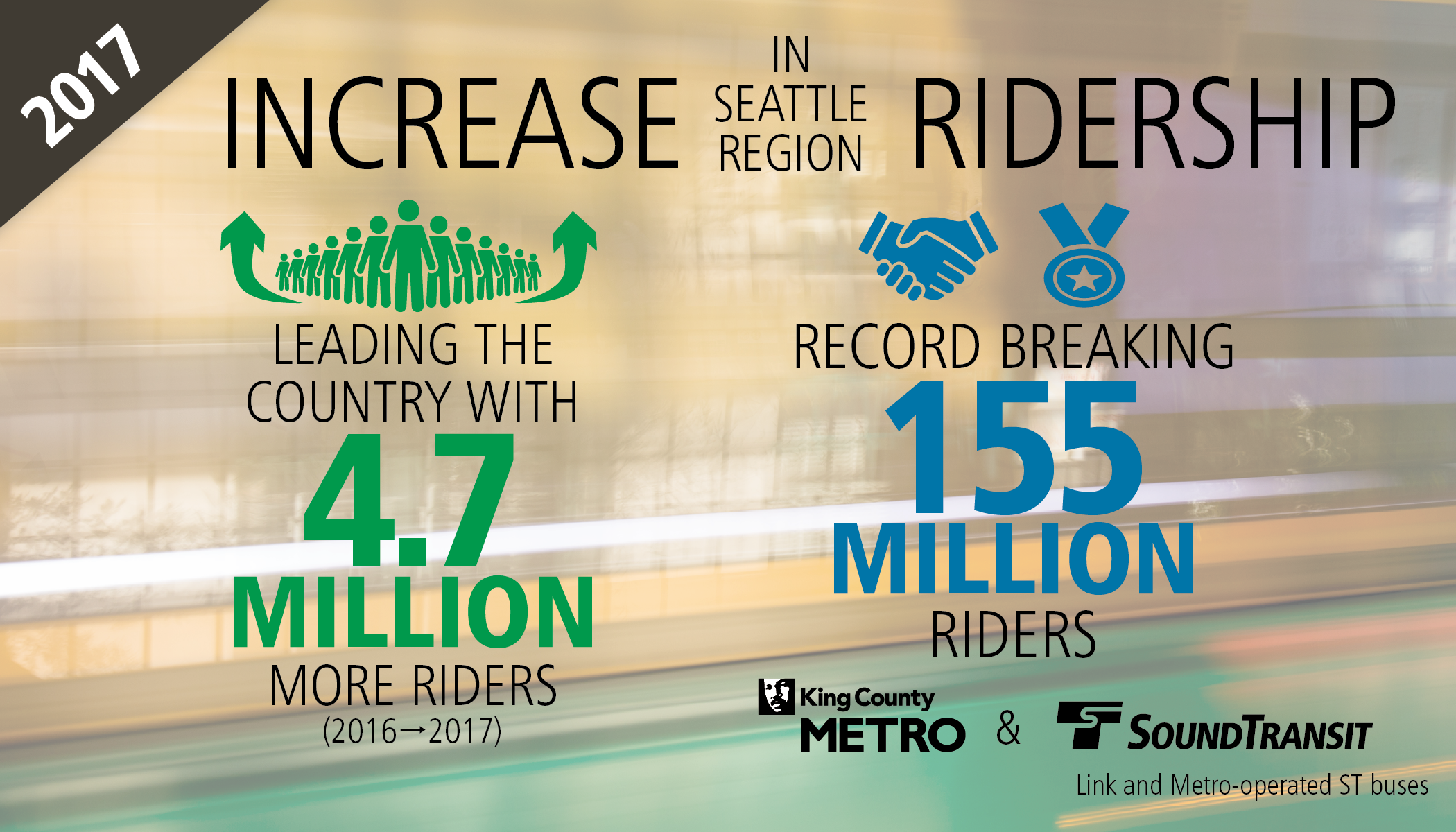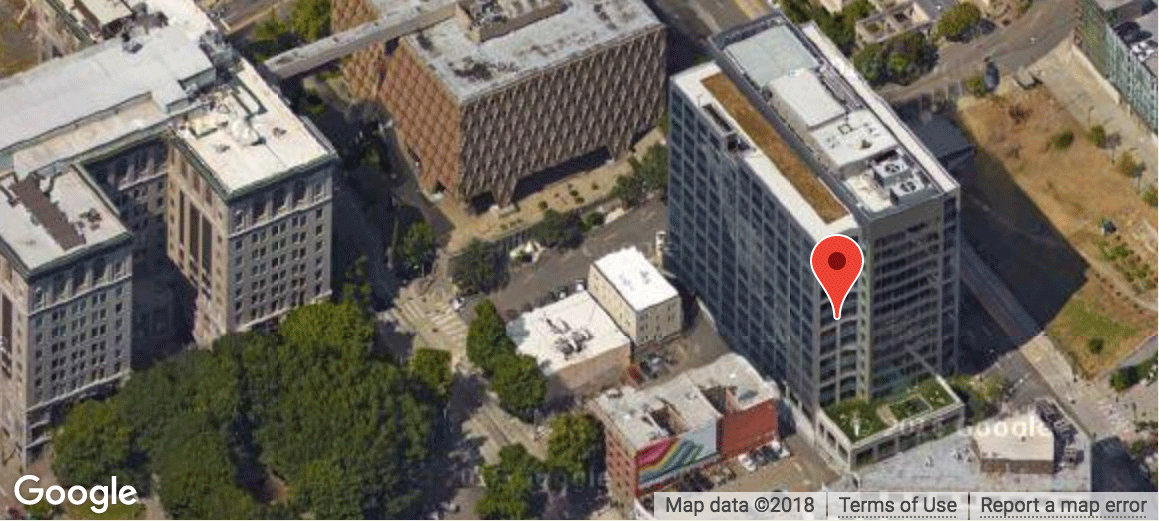Greater Seattle area leads the nation in transit ridership growth
Summary
The greater Seattle-area led the country with the highest growth in people choosing transit, adding 4.7 million trips in 2017 to reach an all-time record high of 191.7 million. The increase follows continued investment in bus and light rail service that together offers riders frequent and reliable travel options.
Story
Strong growth in Metro, Sound Transit and RapidRide – as well as vanpools and shuttles – contributed to the Seattle-area posting record ridership numbers, and leading the nation in year-over-year ridership growth.
“People wanted more bus and light rail options, and we delivered. More service means more riders,” said Executive Dow Constantine. “From operators to transit planners and engineers, we are focusing our energy and resources to meet the demand, and we will deploy more bus service and other innovations on the streets this year and beyond, including more connections to light rail as we further expand the regional network.”
“Sound Transit is moving aggressively ahead to expand regional transit service as ridership on our trains and buses continues to grow,” said Chief Executive Officer Peter Rogoff. “In a few short years, people will be able to ride light rail to Northgate, Bellevue, Federal Way and Lynnwood—with more service to come as we all work together to build a 116-mile regional transit network.”
“Record ridership wouldn’t be possible without the hard work of Metro’s employees – especially its operators, mechanics and shelter cleaners – who together provide a system that provides outstanding service and reliably carries millions of customers every week,” said King County Metro General Manager Rob Gannon.
Transit ridership on Sound Transit Link light rail, Metro bus service and ST Express bus service operated by Metro fueled the growth. Together, these services combined to break records and climb to their highest levels ever: 155 million rides in the King County area – the vast majority of the Seattle-area’s total 191.7 million trips taken in 2017:
- Metro carried a record 122.2 million riders in 2017
- Sound Transit Link light rail carried a record 23.2 million riders, and
- Metro-operated Sound Transit Express service carried 9.6 million riders.
According to ridership reported to the National Transit Database, the Seattle-area ranked first due to the growing number of passenger trips among all major metropolitan areas; the rate of growth – 2.5 percent – ranked second behind only Phoenix, Ariz., (2.7 percent) and ahead of Houston (0.2 percent). From 2015-2016, the Seattle-area posted 4.7 percent growth in ridership - leading the nation with the fastest growing ridership rate among major metropolitan areas.
Coordinating schedules and operations between Metro and Sound Transit helped customers travel smoothly to work, school, appointments and entertainment.
On March 10, Metro will again expand service, bringing transit service levels to 15 percent higher than they were in 2014, thanks to investments by King County and the City of Seattle.
Highlights: More mobility options for riders
In 2017, riders saw major continued investment in transit service expansion by King County Metro. King County’s 2017-2018 budget includes $30 million each year to address crowding, reliability and service expansion needs. Ridership is growing on frequent bus service that connects neighborhoods to train stations and Sound Transit’s Link light rail stations at Capitol Hill, Husky Stadium, and Angle Lake.
- Routes that serve South Lake Union gained approximately 1.4 million weekday rides annually, representing an increase of 5.9 percent over 2016.
- RapidRide A-F lines gained about 840,000 total rides, representing an increase of 4.2 percent over 2016. RapidRide lines carry 1 in 6 Metro bus riders.
- All-day routes serving UW Station gained approximately 520,000 weekday rides annually, representing an increase of 3.3 percent over 2016.
- Light rail ridership up 22 percent over 2016 as Link becomes one of the top choices for riders to get around.
- Only 25 percent of morning commuters to downtown Seattle now report they drive alone; the other 75 percent take buses and trains, vanpool, bike, walk or telecommute, according to a Commute Seattle survey released this month.
- There are now 1,600 active Metro Vanpools and Vanshares, carrying 11,000 registered riders across King County annually.
- Metro’s Community Connections program offers a growing number of mobility options such as shuttles and vans that respond to unique needs of communities throughout King County. In 2017, active services carried more than 105,000 rides in the Snoqualmie Valley, Burien Black Diamond, Enumclaw, Bothell, Woodinville Redmond, Mercer Island and to trailheads in the Issaquah Alps.
Metro continues to monitor ridership and system performance, and analyze crowding and reliability. Over time, ridership is estimated to grow by millions of additional trips annually as riders experience the convenience and reliability of the revised and improved network.
2017 Ridership by the numbers
King County Metro: 122.2 million (121.5 million in 2016; 121.8 million in 2015) for Metro buses (including RapidRide noted below), DART and South Lake Union Streetcar
Sound Transit: 47 million across Link light rail, Sounder, Sound Transit Express and paratransit (42.7 million in 2016; 34.7 million in 2015)
Metro RapidRide: 20.7 million riders on six lines, a 4 percent increase from the 19.9 million that rode in 2016. Metro refined and adjusted these estimates to more accurately reflect passenger counts. Average RapidRide weekday ridership:
- A Line: 9,900
- B Line: 6,500
- C Line: 11,700
- D Line: 14,200
- E Line: 17,200
- F Line: 5,700
Metro vanpools: 3.6 million trips in 1,600 vanpools (3.5 million in 2015 and 2016)
Metro Access: 960,000 trips (960,000 in 2016; 990,000 in 2015)
Metro Community Access Transit: 341,000 trips (348,000 in 2016)
Relevant links
Quotes
People wanted more bus and light rail options, and we delivered. More service means more riders. From operators to transit planners and engineers, we are focusing our energy and resources to meet the demand, and we will deploy more bus service and other innovations on the streets this year and beyond, including more connections to light rail as we further expand the regional network.
Sound Transit is moving aggressively ahead to expand regional transit service as ridership on our trains and buses continues to grow. In a few short years, people will be able to ride light rail to Northgate, Bellevue, Federal Way and Lynnwood—with more service to come as we all work together to build a 116-mile regional transit network.
Record ridership wouldn’t be possible without the hard work of Metro’s employees – especially its operators, mechanics and shelter cleaners – who together provide a system that provides outstanding service and reliably carries millions of customers every week.
For more information, contact:
Alex Fryer, Executive Office, 206-477-7966
Kimberly Reason, Sound Transit, 206-689-3343

 Translate
Translate



